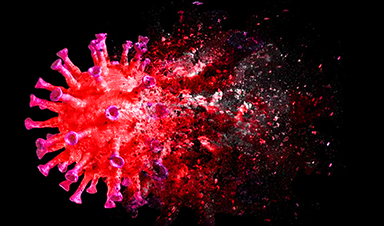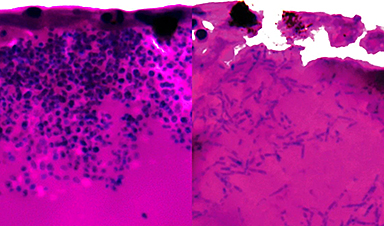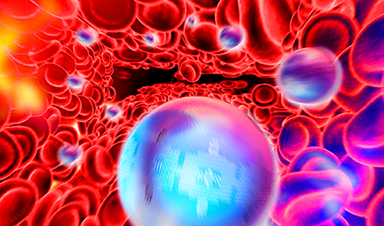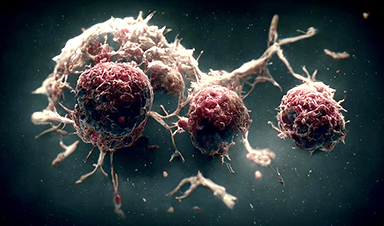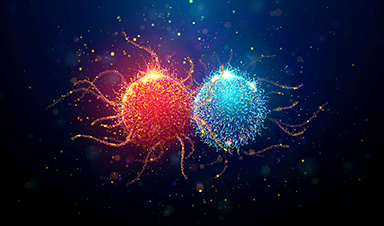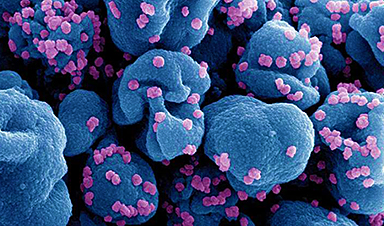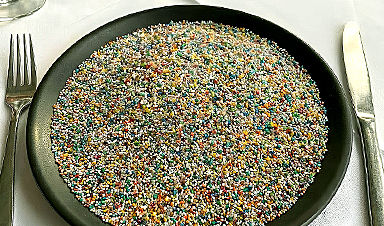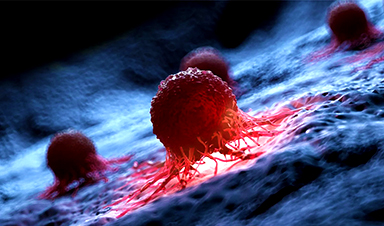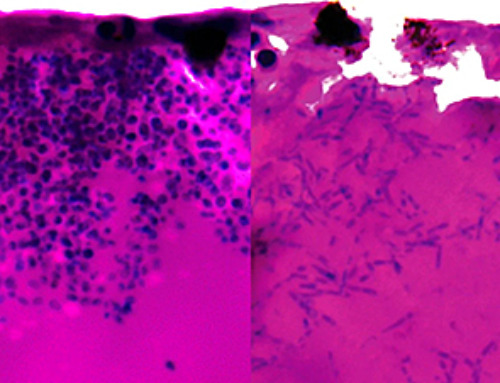A chemical radar allows bacteria to sense and eliminate predators.
Investigating how microorganisms communicate deepens our understanding of the complex ecological interactions that shape our environment is an area of key focus for the Cluster of Excellence “Balance of the Microverse.” A research team from the Cluster, based at the Leibniz Institute for Natural Product Research and Infection Biology – Hans Knöll Institute (Leibniz-HKI) and Friedrich Schiller University Jena, has examined the interactions between amoebae, bacteria, and plants.
Researchers from the University of Bayreuth also contributed to the study. The findings pave the way for discovering new bioactive natural products.
The persistent plant pathogen and a single-celled organism with team spirit
The bacterium Pseudomonas syringae is a ubiquitous and devastating plant pathogen. The pathogen penetrates the plant via natural openings or injuries, infects it, and causes considerable damage in agriculture. Amoebae are natural enemies of the bacterium. The amoeba Polysphondylium pallidum, for instance, is a single-celled organism that feeds on bacteria.
However, if food becomes scarce, the unicellular organisms aggregate to form multicellular structures that allow for the generation and dispersal of spores. While not directly involved in the infection process of the plant, the amoeba is an important predator that forces the bacterium to evolve highly effective defense mechanisms in order to survive in their presence.
An amoeba kills itself
The research team led by Pierre Stallforth, professor at the University of Jena and head of department at the Leibniz-HKI, has now identified a previously unknown defense mechanism of Pseudomonas syringae.
“We were able to show how the bacterium uses a chemical radar to recognize and eliminate the hostile amoebae. Interestingly, the amoebae themselves play a crucial role in their own demise,” says Shuaibing Zhang, first author of the study.
Pierre Stallforth adds: “Pseudomonas syringae produces syringafactins. These are chemical compounds that are harmless to the amoeba, they enable the bacterium to move faster. When the amoeba encounters this molecule, the organism modifies syringafactin’s chemical structure. The bacterium in turn has a special sensor protein – the Chemical Radar Regulator (CraR) – which recognizes these modified molecules. This enables the bacteria to detect the presence of amoebae, whereupon genes responsible for the production of toxic substances – the pyrofactins – are activated. The pyrofactins in turn kill amoebae and, interestingly, are derivatives of the modified syringafactins.”
Defense mechanism provides opportunities for the development of new drugs
The infectivity of the bacterium is also linked to the chemical radar system: P. syringae can only infect thale cress, Arabidopsis thaliana, a very common plant model organism, in the presence of amoebae if the bacterium has an active “chemical radar” and is, therefore, able to defend itself against the predator.
The study provides valuable insights into the complex interplay between microorganisms, protozoa, and higher plants. It also provides starting points for the discovery of new bioactive natural substances that can be useful to humans as drugs or in pest control.
Reference: “A chemical radar allows bacteria to detect and kill predators” by Shuaibing Zhang, Kevin Schlabach, Victor Hugo Pérez Carrillo, Anan Ibrahim, Shahran Nayem, Anna Komor, Ruchira Mukherji, Somak Chowdhury, Lisa Reimer, Felix Trottmann, A. Corina Vlot, Christian Hertweck, Ute A. Hellmich and Pierre Stallforth, 2 April 2025, Cell.
DOI: 10.1016/j.cell.2025.02.033
Numerous fundings made this pioneering study possible under the direction of the Leibniz-HKI, including the Werner Siemens Foundation, the German Research Foundation within the Cluster of Excellence “Balance of the Microverse” and the ChemBioSys Collaborative Research Center. The states of Hessen and Thuringia also supported the project with funding from the European Regional Development Fund (EFRE).
News
Scientists Unlock a New Way to Hear the Brain’s Hidden Language
Scientists can finally hear the brain’s quietest messages—unlocking the hidden code behind how neurons think, decide, and remember. Scientists have created a new protein that can capture the incoming chemical signals received by brain [...]
Does being infected or vaccinated first influence COVID-19 immunity?
A new study analyzing the immune response to COVID-19 in a Catalan cohort of health workers sheds light on an important question: does it matter whether a person was first infected or first vaccinated? [...]
We May Never Know if AI Is Conscious, Says Cambridge Philosopher
As claims about conscious AI grow louder, a Cambridge philosopher argues that we lack the evidence to know whether machines can truly be conscious, let alone morally significant. A philosopher at the University of [...]
AI Helped Scientists Stop a Virus With One Tiny Change
Using AI, researchers identified one tiny molecular interaction that viruses need to infect cells. Disrupting it stopped the virus before infection could begin. Washington State University scientists have uncovered a method to interfere with a key [...]
Deadly Hospital Fungus May Finally Have a Weakness
A deadly, drug-resistant hospital fungus may finally have a weakness—and scientists think they’ve found it. Researchers have identified a genetic process that could open the door to new treatments for a dangerous fungal infection [...]
Fever-Proof Bird Flu Variant Could Fuel the Next Pandemic
Bird flu viruses present a significant risk to humans because they can continue replicating at temperatures higher than a typical fever. Fever is one of the body’s main tools for slowing or stopping viral [...]
What could the future of nanoscience look like?
Society has a lot to thank for nanoscience. From improved health monitoring to reducing the size of electronics, scientists’ ability to delve deeper and better understand chemistry at the nanoscale has opened up numerous [...]
Scientists Melt Cancer’s Hidden “Power Hubs” and Stop Tumor Growth
Researchers discovered that in a rare kidney cancer, RNA builds droplet-like hubs that act as growth control centers inside tumor cells. By engineering a molecular switch to dissolve these hubs, they were able to halt cancer [...]
Platelet-inspired nanoparticles could improve treatment of inflammatory diseases
Scientists have developed platelet-inspired nanoparticles that deliver anti-inflammatory drugs directly to brain-computer interface implants, doubling their effectiveness. Scientists have found a way to improve the performance of brain-computer interface (BCI) electrodes by delivering anti-inflammatory drugs directly [...]
After 150 years, a new chapter in cancer therapy is finally beginning
For decades, researchers have been looking for ways to destroy cancer cells in a targeted manner without further weakening the body. But for many patients whose immune system is severely impaired by chemotherapy or radiation, [...]
Older chemical libraries show promise for fighting resistant strains of COVID-19 virus
SARS‑CoV‑2, the virus that causes COVID-19, continues to mutate, with some newer strains becoming less responsive to current antiviral treatments like Paxlovid. Now, University of California San Diego scientists and an international team of [...]
Lower doses of immunotherapy for skin cancer give better results, study suggests
According to a new study, lower doses of approved immunotherapy for malignant melanoma can give better results against tumors, while reducing side effects. This is reported by researchers at Karolinska Institutet in the Journal of the National [...]
Researchers highlight five pathways through which microplastics can harm the brain
Microplastics could be fueling neurodegenerative diseases like Alzheimer's and Parkinson's, with a new study highlighting five ways microplastics can trigger inflammation and damage in the brain. More than 57 million people live with dementia, [...]
Tiny Metal Nanodots Obliterate Cancer Cells While Largely Sparing Healthy Tissue
Scientists have developed tiny metal-oxide particles that push cancer cells past their stress limits while sparing healthy tissue. An international team led by RMIT University has developed tiny particles called nanodots, crafted from a metallic compound, [...]
Gold Nanoclusters Could Supercharge Quantum Computers
Researchers found that gold “super atoms” can behave like the atoms in top-tier quantum systems—only far easier to scale. These tiny clusters can be customized at the molecular level, offering a powerful, tunable foundation [...]
A single shot of HPV vaccine may be enough to fight cervical cancer, study finds
WASHINGTON -- A single HPV vaccination appears just as effective as two doses at preventing the viral infection that causes cervical cancer, researchers reported Wednesday. HPV, or human papillomavirus, is very common and spread [...]




